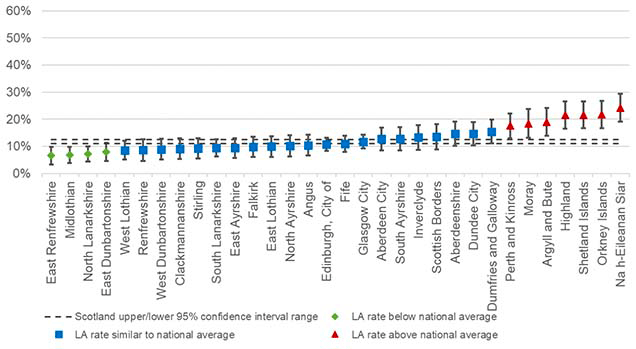Scottish House Condition Survey: Local Authority Analysis 2017-2019
Local Authority figures for 2017-2019, including fuel poverty rates, energy efficiency ratings, the condition of housing and the Scottish Housing Quality Standard.
This document is part of a collection
Extreme Fuel Poverty
Extreme fuel poverty follows the same definition as fuel poverty except that a household would have to spend more than 20% of its adjusted net income (after housing costs) on total fuel costs to maintain a satisfactory heating regime.
In the period 2017-2019, the extreme fuel poverty rate varied from 7% in East Renfrewshire to 24% in Na h-Eileanan Siar compared to the average in Scotland of 12% (Figure 6). Seven local authorities had significantly higher extreme fuel poverty rates than the national average, these were: Na h-Eileanan Siar (24%), Orkney Islands (22%), Shetland Islands (22%), Highland (22%), Argyll and Bute (19%), Moray (19%) and Perth and Kinross (18%). All of these local authorities had a greater prevalence than average of lower energy efficient properties (those rated EPC F or G; Figure 3).
Four local authorities had significantly lower extreme fuel poverty rates than the national average, these were: East Renfrewshire (7%), Midlothian (7%), North Lanarkshire (7%) and East Dunbartonshire (8%). Midlothian and North Lanarkshire have a higher prevalence of higher energy efficient homes (those rated B or C; Figure 4) compared to the national average. East Renfrewshire and East Dunbartonshire have a similar prevalence of higher energy efficient homes compared to the national average.

Note: In this chart, the fuel poverty rate for Scotland as a whole is a three-year average. This is different to the proportion published in the main SHCS Key Findings report, which is an annual figure. These are a best estimate of extreme fuel poverty under the new definition of fuel poverty and therefore cannot be compared to statistics published under the old definition in local authority analyses prior to 2016-2018.
Contact
Email: shcs@gov.scot
There is a problem
Thanks for your feedback